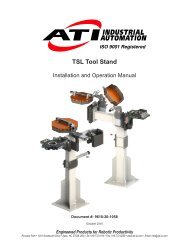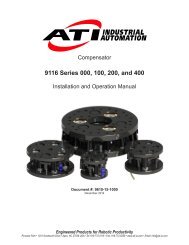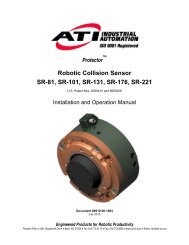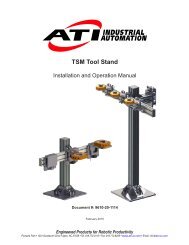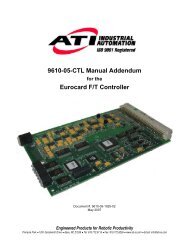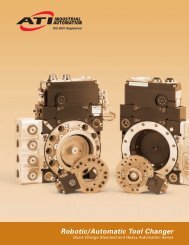Network Force/Torque Sensor System
Net F/T Manual - ATI Industrial Automation
Net F/T Manual - ATI Industrial Automation
Create successful ePaper yourself
Turn your PDF publications into a flip-book with our unique Google optimized e-Paper software.
Net F/T Installation and Operation Manual<br />
Document: 9620-05-net ft-11<br />
Operation is used. It is best to select CAN Bus when neither protocol is<br />
needed; otherwise a DeviceNet protocol failure will be signaled. EtherNet/IP<br />
protocol must be disabled when DeviceNet protocol is enabled.<br />
CAN Bus Base<br />
Address:<br />
DeviceNet MAC ID:<br />
Baud Rate:<br />
Displays the base address to be used by the CAN bus protocol. See Section<br />
3.10.2—Node Address for information on setting this address.<br />
Displays the DeviceNet MAC ID address to be used by the DeviceNet<br />
compatibility-mode protocol. See Section 3.10.2—Node Address for<br />
information on setting this address.<br />
Displays the CAN bus baud rate used by the CAN network. See Section<br />
3.10.3—Baud Rate for information on setting the baud rate.<br />
NOTICE: The values displayed for CAN Bus Base Address, DeviceNet MAC ID, and Baud<br />
Rate are only valid if power is supplied to the Pwr/CAN connector. Otherwise indeterminate<br />
data is displayed.<br />
Raw Data Transfer (RDT) Settings:<br />
RDT Interface:<br />
RDT Output Rate:<br />
RDT Buffer Size:<br />
Multi-Unit<br />
Synchronization:<br />
Multi-Unit ID:<br />
Ethernet/IP O2T Data<br />
If enabled, the Net Box will be allowed to establish a point-to-point UDP<br />
connection to a host computer. This is the fastest way to read F/T data from<br />
the sensor system. In Section 10—UDP Interface Using RDT the RDT<br />
interface is described in detail. RDT data is routed through the local network<br />
and does not get routed through the default gateway.<br />
The rate per second at which the Net Box will send streaming RDT data to a<br />
host. It can be adjusted in integer fractions of 7000. (e.g., 7000÷2=3500 or<br />
7000÷3=2333). If you enter a different sample rate, the Net F/T will<br />
automatically change to the next higher possible sample rate.<br />
The RDT interface can operate in different modes. One of these is the Buffer<br />
Mode where the Net Box sends more than one data package per sample.<br />
Multiple data packages are buffered and sent in one block. This reduces the<br />
amount of overhead data to be sent with the effect of reducing the overall<br />
network traffic. The number of data sets per block is the Buffer Mode Size.<br />
If enabled, the Net Box will synchronize its RDT data output with other Net<br />
F/T sensor systems on the same network. In a network with only one sensor<br />
system, this option should be disabled. Refer to Section 10.3—Multi-Unit<br />
Mode for details. Multi-Unit IDs must be assigned for this to work correctly.<br />
If Multi-Unit Synchronization is enabled, each Net F/T using multi-unit<br />
synchronization needs to have a unique ID assigned to it.<br />
If enabled, the Net F/T accepts a 4-byte output bitmap which is identical to the<br />
Profinet bitmap in table 15.3. If disabled, the Net F/T does not accept any<br />
Ethernet/IP output data (the same as the current version of the product).<br />
Pinnacle Park • 1031 Goodworth Drive • Apex, NC 27539 USA • Tel: +1.919.772.0115 • Fax: +1.919.772.8259 • www.ati-ia.com • Email: info@ati-ia.com<br />
B - 47



